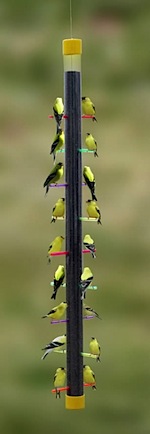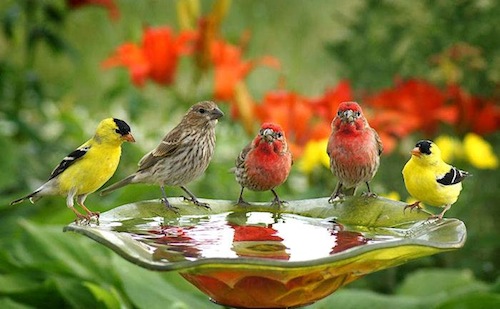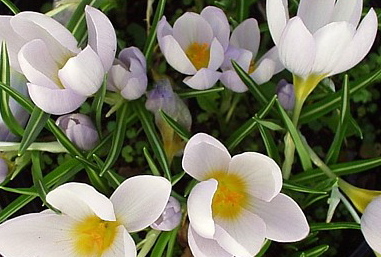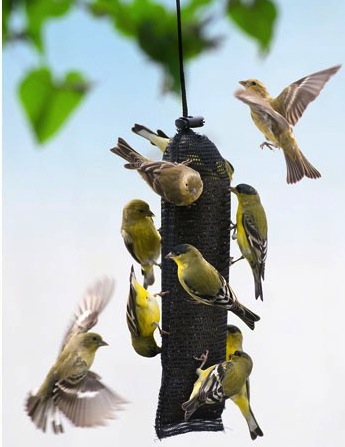-
Nyjer Feeders are Busy Now
They’re the last ones of the season to nest and raise their young, they’re also the only ones who molt twice per year. It really puts goldfinches in a class of their own. It’s the busy season for them, feeding the tiny black seed almost exclusively to babies. During the year, spells of non-activity may be common around nyjer feeders… but not now!
If you offer nyjer or thistle seed year-round, chances are great these birds will stick around. They won’t nest in a birdhouse, but prefer mature trees and shrubs for building their digs. Considered resident birds, in winter you’ll see dull brown-olive plumage, but their sweet song will still grace the garden on the dreariest days. A fresh water source will further entice these friendly fliers.
A fickle seed nyjer can be, it must be fresh for the birds to partake. Should the seed sit in your feeder too long, it may become moldy or rancid and they won’t touch it. One of the benefits of this long tube feeder is the ability to fill it from both ends. By alternating top and bottom refills, there’s no way for older seed to accumulate at the bottom like most feeders.
Another popular style is mesh or screen, offering an all-over feeding space as opposed to individual perches. In recycled plastic, some are durable enough to last a lifetime.
And the last benefit of thistle? It won’t germinate! You’ll never see a nasty weed below these feeders. So fill it up, keep seed fresh, offer a bathing spot and American goldfinches are bound to claim your garden as home sweet home!
-
Why Place Finch Feeders Near a Bird Bath?
Photo courtesy of Evolve Campaigns Fresh water is known to entice more feathered friends than any single feeder or birdhouse. One of the critical elements for just about any life form, birds require fresh water, even in the harshest winter weather. Sure they can eat snow, but it takes work to convert the snow into water and uses precious calories needed to stay warm. That’s why heated baths and de-icers are so popular among dedicated backyard birders-especially this past winter, no… make that this persistent winter!
With the first bulbs forcing through, it
means spring’s around the corner… even if there’s still snow on the ground in your neck of the woods! The calendar and number of hours of daylight are signaling birds it’s time for nesting, to claim a spot, settle down and raise their broods. Although American goldfinches and house finches don’t use natural cavities (or birdhouses) for nesting, you can absolutely attract these cool little fliers to your place with finch feeders and a fresh water source.
Goldfinches can be seen chowing down on straight nyjer or thistle seed (their preferred meal), as well as finch mixes containing finely chopped sunflower hearts and thistle. The latter being more likely to attract a wider variety of species. House and purple finches, cardinals, pine siskins, towhees and several types of sparrows are commonly seen visiting finch feeders.
The timid demeanor of the vibrant yellow goldfinch keeps them from competing at feeders among crowds. They’d actually prefer to just give up and fly off than to fight for a chance to eat. This not very characteristic of too many birds!
A great way to offer extra feeding space during the busy finch season (without buying several full-blown feeders) is to offer thistle socks. Convenient and inexpensive, these smaller mesh feeders provide several birds a good meal instead of a missed opportunity!
One of very few birds who molts twice per year, their electric yellow breeding plumage has started developing. When all other birds are just about through with nesting for the season, goldfinches are just getting started! Their busy season? Late June through July.
Though they might not be sporting that amazing yellow color, goldfinches are still around. Keep thistle and finch feeders out year-round for best results, to see more of these delightful feathered friends at your place!





